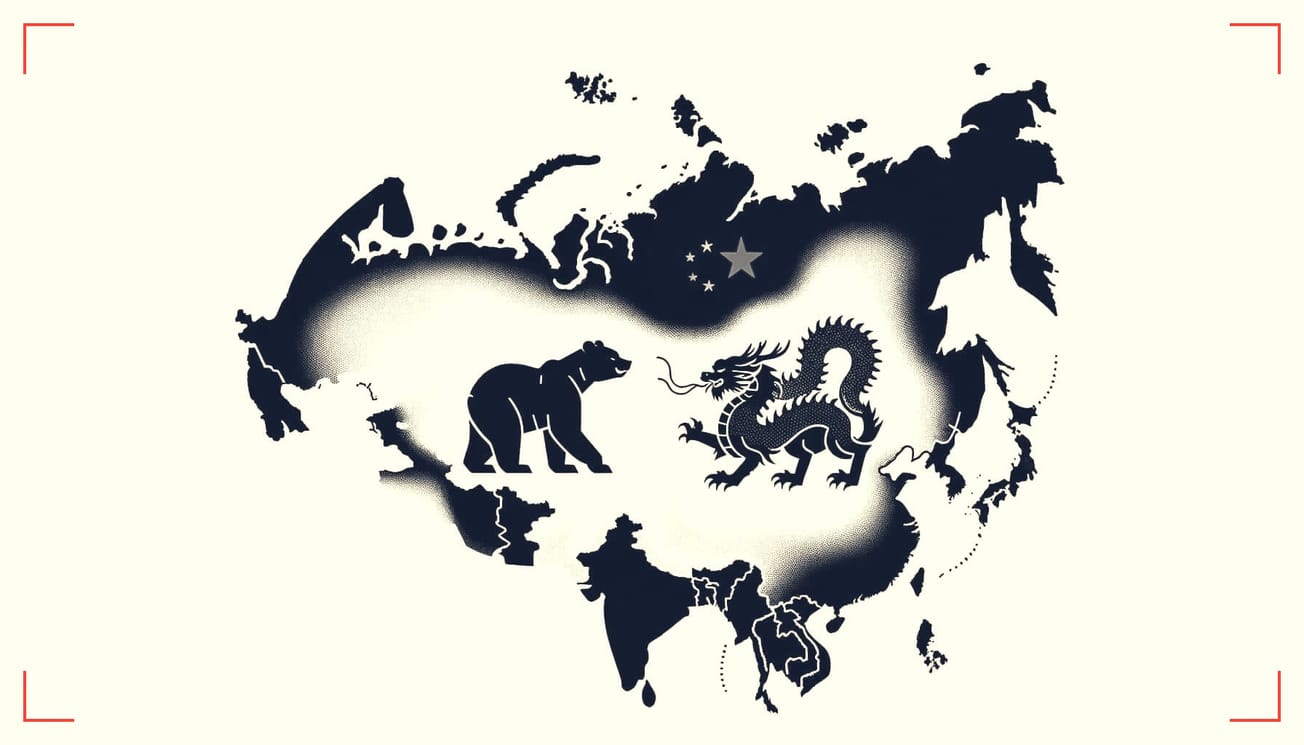

+ Russia’s historical dominance in Central Asia is waning as countries in the region assert their independence and engage more with global powers, diversifying their security and economic partnerships away from Moscow’s influence.
+ Central Asian countries are actively seeking to recalibrate their security and economic strategies, engaging with the US, China, and the EU to reduce reliance on Russia, including through joint military exercises, significant foreign investments, and enhanced diplomatic engagements.
+ Despite Russia’s declining military and economic influence, it remains a significant player in Central Asia, with its legacy and current engagements ensuring a continued, albeit reduced, role in the region’s geopolitical and economic landscapes.
+ The shifting power dynamics in Central Asia present both opportunities and challenges for businesses, with the potential for increased investment and economic engagement counterbalanced by the risks of sanctions, regional instability, and the complexities of navigating changing relationships.
Russia's Waning Powerbroker Pretense
Russia has held a hegemonic position in Central Asia since the demise of the Soviet Union. Historical ties, institutionalized through organizations such as the Eurasian Economic Union (EEU) and security agreements such as the Collective Security Treaty Organization (CSTO), endowed Russia with significant influence, albeit one in gradual decline. This decline has intensified significantly since the full-scale invasion of Ukraine in February 2022. Central Asian countries have taken advantage of Moscow’s distraction to more successfully assert their independence and more effectively balance major regional and global powers. That said, while Russia’s relative influence has declined, it is still a major player in the region, with a rebalancing (rather than re-orientation) of relations between Russia and Central Asian states taking place. This has a number of implications for businesses caught up in the geopolitical currents, as well as the wider commercial landscape in the region.
Russia has recently found itself unable or unwilling to fulfill its desired role as “peacekeeper” and mediator in regional conflicts. Whilst Russian-led CSTO forces intervened to put down anti-government protests in Kazakhstan in January 2022, Russian military influence in other regional conflicts precipitously declined. Russia was unable to enforce its own ceasefire between Azerbaijan and Armenia in Nagorno-Karabakh, failing to stop a September 2023 military offensive by Baku. Indeed, the latter situation may have been motivated by Russian recognition of its own weaknesses, and a desire to “pick a winner” in a conflict it could not prevent so as to avoid the embarrassment of failing to stop an Azerbaijani offensive. Similarly, Russia failed to intervene in the September 2022 border conflict between CSTO members Kyrgyzstan and Tajikistan, and even reportedly reduced troop numbers in both countries, materially reducing its military influence. The reputation of the CSTO, such as it was, also appears in decline; not only did Russia not come to member Armenia’s aid against an external power, but Moscow was also unable to prevent infighting between members Kyrgyzstan and Tajikistan. As such, Moscow’s increasingly nominal role of security guarantor, mediator, or even “older brother” appears significantly undermined.
Notably, Central Asian countries have begun to seek alternate security providers. These efforts are unlikely to portend a major re-alignment, yet they are still unprecedented in the post-Soviet era. Armenia undertook joint exercises with the US in September 2023, and the US opened a new Peacekeeping Operations Center in Almaty, Kazakhstan in October 2023. More recently, France and Armenia deepened defense ties, with Yerevan purchasing military equipment from Paris. Armenian PM Pashinyan recently noted that the CSTO “hasn’t fulfilled its security obligations towards Armenia”. China has also made limited efforts at security cooperation in the region. Beijing has outlined a plan for defense and security cooperation with Astana, and is believed to seek a formal security arrangement, particularly against Islamic extremism. This shift towards diversifying security alliances marks a limited but clear evolution in Central Asia’s geopolitical posture, reflecting a growing autonomy and strategic recalibration away from Moscow.
This shift towards diversifying security alliances marks a limited but clear evolution in Central Asia’s geopolitical posture, reflecting a growing autonomy and strategic recalibration away from Moscow.
Economically, Russian influence has also declined. Central Asian countries have ostensibly complied with Western sanctions regimes. Kazakhstan, for example, has instituted an electronic system to monitor goods transiting the country for re-export, in a conspicuous effort to avoid Western ire or secondary sanctions. Indeed, outside powers have attempted to deepen ties in the region amidst Russian economic isolation. China, a longstanding major (and growing) investor in the region, announced nearly $4bn of investment across Kazakhstan, Uzbekistan, Kyrgyzstan, Tajikistan and Turkmenistan in May 2023, and this is with Uzbekistan having already signed a $16bn trade and investment deal with Beijing in September 2022. Indeed, a major signal of China’s emerging economic pre-eminence in the region came last year, when China supplanted Russia as Kazakhstan’s largest trading partner.
The EU has also been increasing outreach efforts, with Kazakhstan being termed a “focal point” of the EU’s Global Gateway Initiative in the region, aimed at strengthening ties with emerging economies. For example, the European Bank for Reconstruction and Development expressed readiness in January 2024 to invest around €1.5 billion in the regional Trans-Caspian Corridor infrastructure project over the next 2-3 years. In addition, Germany has begun to import increasing quantities of oil from the region, boosting trade with Almaty by 80%, and by 111% with Uzbekistan in the first half of 2022 alone. Similarly, the US has also increased political engagement with the region, sending Secretary of State Anthony Blinken to both Kazakhstan and Uzbekistan in 2023, the first such visit in over three years. Additionally, the US hosted its first C5+1 summit of Central Asian countries in New York this year, launched the B5+1 initiative to boost private sector-led development, and announced the $50m Economic Resilience Initiative in Central Asia to spur regional development. Private US companies are also investing in the region, such as Pennsylvania-based Air Products’s $1bn investment into Kazakh natural gas processing. As such, it appears clear that Russian economic influence is being eroded by competing major powers.
A Russian Dependency is Hard to Break
Despite the above developments, Moscow still exerts potent sway in Central Asia, thanks to the economic and political legacy of the region’s inclusion in the Russian Empire, and later in the USSR. Outside security cooperation remains limited. Decades of Soviet and Russian military influence in the region has driven doctrine, mindsets, and procurement decisions, and such institutional genealogy cannot be erased quickly. Regional security forces enjoy close working relationships with their Russian analogues and Russian materiel at discounted prices, and have an established history of conducting joint military exercises. Indeed, Russia still retains military bases in the region, including its largest foreign military base in Tajikistan.
Decades of Soviet and Russian military influence in the region has driven doctrine, mindsets, and procurement decisions, and such institutional genealogy cannot be erased quickly.
Russian economic ties and influence in the region are still strong, despite what may seem to be significant setbacks. Although adhering to Western sanctions in principle, regional trade with Moscow has actually increased, rising by 20% in 2022. Trade increases with Kazakhstan were particularly pronounced, growing by 42% between January-September 2022 compared with the same timeframe in 2021.
Countries in Central Asia have also facilitated Russian sanctions evasion through re-exports of controlled goods and parallel imports, but also by obscuring exports of commodities like oil to Western countries. Indeed, exports from the UK and EU to Armenia, Kyrgyzstan, and Kazakhstan increased by 90% after sanctions imposition, with some goods being high-tech items used by the Russian military. Researchers have found that Russian citizens have established companies in Kazakstan to import sensitive electronics such as microchips and drones. Even seemingly benign items like washing machines are a critical source of microchips and other controlled components, stripped for parts once arriving in Russia: Kazakh exports of washing machines to Russia increased from zero in 2021 to nearly 100,000 in 2022. In one notable example, British exports to Kazakhstan have risen over 1,100% since the outbreak of the war in Ukraine, being dominated by vehicles and heavy machinery which are prohibited from direct export by sanctions. Whilst some countries in the region have made some efforts to throttle sanctions evasion, the size of the Russian market and lucrative nature of sanctions-busting, and the need to maintain good ties with Moscow, likely means such illicit activity will continue.
Compared to other Central Asian states, Russia does have a large economy and still possesses a number of instruments to engage and influence the economies of the region, with whom it has historically fostered deep dependencies. Russia remains a large (if not the preponderant) export destination and import source for many of the region’s goods. Russia uses this to exert leverage over populations and governments across the region. Central Asia relies on Russian wheat and sugar exports; Russia’s ban on grain exports to the EEU in 2022 caused grain deficits, price increases, and inflation.
Additionally, Russian territory serves as a key transit route, transporting some 80% of Uzbekistan’s imports and exports. Notably, Kazakhstan’s oil and gas exports, Almaty’s primary revenue source, rely overwhelmingly on Russian pipelines. 94% of Kazakh oil exports travel via Russian pipelines, with one particular route, the CPC to the Black Sea port of Novorossiysk, accounting for approximately 80% of all exports. Russia has in the past cut oil exports to register disapproval with Almaty’s policy choices. It is unlikely to be a coincidence that Novorossiysk port was closed down in June and July 2022, after Almaty announced compliance with Western sanctions on Russia and after Almaty signaled its willingness to export more oil to the EU.
As such, Russia remains a significant economy, deeply integrated into those of Central Asia and endowed with a number of ways to coerce the region. China may indeed replace Russia as the main economic partner of Central Asia, but Moscow will remain a key player in the region’s economy; the US and EU are likely to remain smaller players. Russian influence has certainly declined in the region, but predictions of its demise are premature. Moscow’s close proximity, historical ties, and economy, albeit reduced, still endows it with much influence, if somewhat changed or attenuated.
Implications for Commercial Interests
Today, the commercial sector is playing an outsized and independent role in regional developments. Accordingly, the numerous factors discussed above have a number of key impacts for private business. The economic rebalancing taking place in the region presents an opportunity for outside investors, especially as Central Asia seeks foreign investment. Oil, gas, and other extractive industries are likely to be particularly welcomed, given the region’s wealth of natural resources. Infrastructure development and engineering concerns would also likely profit from opportunities to reinvigorate the region’s poor infrastructure.
Businesses looking to operate in Central Asia must recognize that Russia’s declining dominance in the region represents less a wholesale reorientation of those countries away from Moscow, and more a strategic rebalancing of their relationships with it.
However, businesses operating within Central Asia, or partnering with those based there, may be exposed to sanctions risk, particularly secondary sanctions from Western countries. Western secondary sanctions have targeted those aiding in Russian efforts to evade sanctions, with an Uzbek firm being proscribed by the US as early as June 2022. A number of Kyrgyz businesses and individuals have also been sanctioned. Secondary sanctions against Kazakh entities have been floated in the past by EU officials, which could result in monetary or reputational loss for businesses concerned. Kazakhstan’s leading regional economy and natural resource wealth may make it a destination of choice for outside investment. However, with the country’s recent reputation as a principal enabler of sanctions evasion in the region, Kazakh businesses may come under increased scrutiny in the future.
Additionally, Russia may take steps to regain influence or coerce countries of Central Asia for perceived disloyalty or realignment, using similar methods as outlined above. For example, should regional governments deepen energy ties with Western states, Russian port and pipeline shutdowns are likely to re-occur. These ties mitigate Moscow’s efforts to coerce European countries using energy supplies over the Ukraine war, so such retaliation would be expected, and would be particularly acute given the paucity of alternate supply routes from the region. Whilst full embargoes are unlikely, more repeated or lengthy shut-offs may occur, impacting business continuity in the region.
Lastly, the outside possibility of regional conflicts, which Moscow is unable to manage, may pose significant risks to business. If Russia’s inability to prevent or end conflicts persists, regional powers may seek to take advantage of this, such as further military action by Azerbaijan against Armenia. A repeat of 2022’s or 2023’s conflicts could expose businesses to supply chain shocks, and reputational and even physical risk. Sanctions on aggressor countries may also be imposed, further increasing compliance risks to business.
Businesses looking to operate in Central Asia must recognize that Russia’s declining dominance in the region represents less a wholesale reorientation of those countries away from Moscow, and more a strategic rebalancing of their relationships with it. Historically, Russia has cemented its influence across the region, first through empire, then the Soviet Union, and in the post-Soviet era through economic dependencies, strategic alliances, and institutional frameworks. For businesses operating within these geopolitical currents, complex international sanctions brought on by Russia’s invasion of Ukraine loom over everything. And the shifting power dynamics imply increased likelihood of regional instability, with business continuity impacts expected to follow. The commercial sector, both within and outside the region, must adapt to this evolving operational context.








